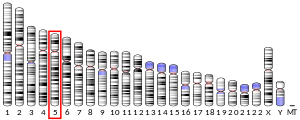ZNF366
Zinc finger protein 366, also known as DC-SCRIPT (Dendritic cell-specific transcript), is a protein that in humans is encoded by the ZNF366 gene.[4] The ZNF366 gene was first identified in a DNA comparison study between 85 kb of Fugu rubripes sequence containing 17 genes with its homologous loci in the human draft genome.[5]
Function
In 2006, DC-SCRIPT was isolated and characterized in human monocyte-derived dendritic cells (mo-DCs).[6]
DC-SCRIPT contains a DNA-binding domain (11 C2H2 zinc (Zn) fingers), flanked by a proline-rich and an acidic region, which can interact with C-terminal-binding protein 1 (CtBP1), a global corepressor. In the immune system of both mice and humans, DC-SCRIPT was found to be specifically expressed in dendritic cells (DCs).[7]
In COS-1 cells, DC-SCRIPT was shown to interact with the estrogen receptor DNA-binding domain (ERDBD) and represses ER activity through the association with RIP140, CtBP and histone deacetylases.[8]
Breast cancer
In 2010, it was shown that DC-SCRIPT can act as a coregulator of multiple nuclear receptors having opposite effects on type I vs type II NRs. DC-SCRIPT is able to repress ER and PR mediated transcription, whereas it can activate transcription mediated by RAR and PPAR. In the same study, it was shown that breast tumor tissue expresses lower levels of DC-SCRIPT than normal breast tissue from the same patient and that DC-SCRIPT mRNA expression is an independent prognostic factor for good survival of breast cancer patients with estrogen receptor- and/or progesterone receptor-positive tumors.[9]
References
- GRCh38: Ensembl release 89: ENSG00000178175 - Ensembl, May 2017
- "Human PubMed Reference:". National Center for Biotechnology Information, U.S. National Library of Medicine.
- "Mouse PubMed Reference:". National Center for Biotechnology Information, U.S. National Library of Medicine.
- "Entrez Gene: ZNF366 zinc finger protein 366".
- Gilligan P, Brenner S, Venkatesh B (July 2002). "Fugu and human sequence comparison identifies novel human genes and conserved non-coding sequences". Gene. 294 (1–2): 35–44. doi:10.1016/S0378-1119(02)00793-X. PMID 12234665.
- Triantis V, Trancikova DE, Looman MW, Hartgers FC, Janssen RA, Adema GJ (January 2006). "Identification and characterization of DC-SCRIPT, a novel dendritic cell-expressed member of the zinc finger family of transcriptional regulators". J. Immunol. 176 (2): 1081–9. doi:10.4049/jimmunol.176.2.1081. PMID 16393996.
- Triantis V, Moulin V, Looman MW, Hartgers FC, Janssen RA, Adema GJ (May 2006). "Molecular characterization of the murine homologue of the DC-derived protein DC-SCRIPT". J. Leukoc. Biol. 79 (5): 1083–91. doi:10.1189/jlb.1005588. hdl:2066/49437. PMID 16522745.
- Lopez-Garcia J, Periyasamy M, Thomas RS, Christian M, Leao M, Jat P, Kindle KB, Heery DM, Parker MG, Buluwela L, Kamalati T, Ali S (2006). "ZNF366 is an estrogen receptor corepressor that acts through CtBP and histone deacetylases". Nucleic Acids Res. 34 (21): 6126–36. doi:10.1093/nar/gkl875. PMC 1693901. PMID 17085477.
- Ansems M, Hontelez S, Looman MW, Karthaus N, Bult P, Bonenkamp JJ, Jansen JH, Sweep FC, Span PN, Adema GJ (January 2010). "DC-SCRIPT: nuclear receptor modulation and prognostic significance in primary breast cancer". J. Natl. Cancer Inst. 102 (1): 54–68. doi:10.1093/jnci/djp441. PMID 20008677.
Further reading
- Hartley JL, Temple GF, Brasch MA (2001). "DNA Cloning Using In Vitro Site-Specific Recombination". Genome Res. 10 (11): 1788–95. doi:10.1101/gr.143000. PMC 310948. PMID 11076863.
- Wiemann S, Weil B, Wellenreuther R, et al. (2001). "Toward a Catalog of Human Genes and Proteins: Sequencing and Analysis of 500 Novel Complete Protein Coding Human cDNAs". Genome Res. 11 (3): 422–35. doi:10.1101/gr.GR1547R. PMC 311072. PMID 11230166.
- Strausberg RL, Feingold EA, Grouse LH, et al. (2003). "Generation and initial analysis of more than 15,000 full-length human and mouse cDNA sequences". Proc. Natl. Acad. Sci. U.S.A. 99 (26): 16899–903. doi:10.1073/pnas.242603899. PMC 139241. PMID 12477932.
- Ota T, Suzuki Y, Nishikawa T, et al. (2004). "Complete sequencing and characterization of 21,243 full-length human cDNAs". Nat. Genet. 36 (1): 40–5. doi:10.1038/ng1285. PMID 14702039.
- Wiemann S, Arlt D, Huber W, et al. (2004). "From ORFeome to Biology: A Functional Genomics Pipeline". Genome Res. 14 (10B): 2136–44. doi:10.1101/gr.2576704. PMC 528930. PMID 15489336.
- Mehrle A, Rosenfelder H, Schupp I, et al. (2006). "The LIFEdb database in 2006". Nucleic Acids Res. 34 (Database issue): D415–8. doi:10.1093/nar/gkj139. PMC 1347501. PMID 16381901.
External links
- ZNF366+protein,+human at the US National Library of Medicine Medical Subject Headings (MeSH)
This article incorporates text from the United States National Library of Medicine, which is in the public domain.

